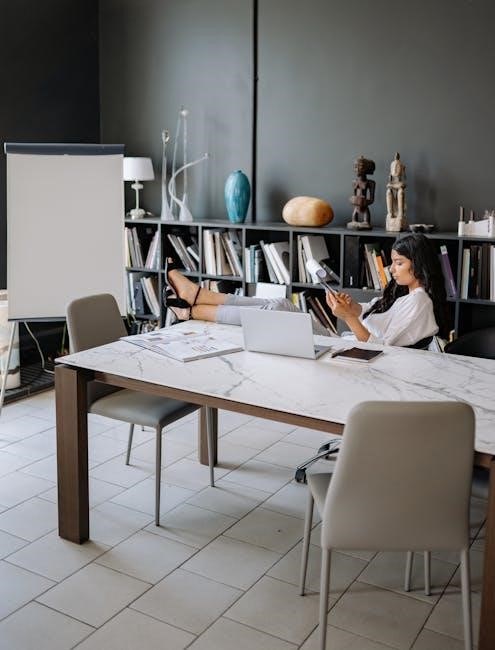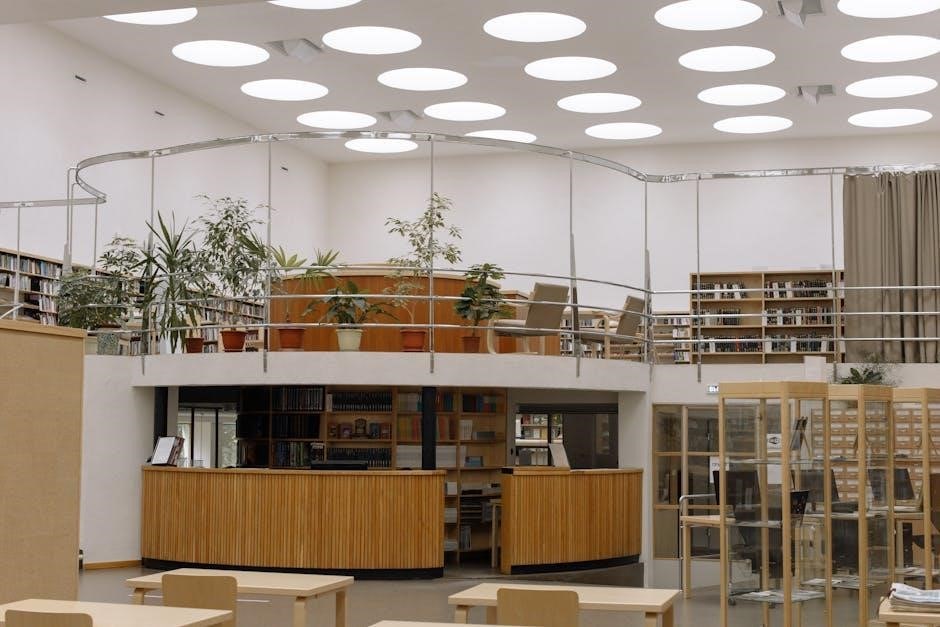Discover comprehensive guides and downloadable PDFs for building custom built-in bookcases. These plans offer step-by-step instructions, materials lists, and tips for creating functional and stylish storage solutions.

Importance of Built-In Bookcases

Built-in bookcases are a valuable addition to any home, offering both functional storage and aesthetic appeal. They provide a custom fit for your space, maximizing room efficiency while creating a polished look. Unlike freestanding shelves, built-ins are seamlessly integrated into walls, offering timeless style and durability. These bookcases are perfect for organizing books, decor, and personal items while enhancing the overall design of a room. Their versatility allows for customization to suit various interiors, from modern to traditional. By incorporating built-in bookcases, homeowners can add practical storage and elevate their living spaces, making them a worthwhile investment for any home improvement project.
Benefits of Using PDF Plans
PDF plans for built-in bookcases offer a comprehensive guide, providing step-by-step instructions, detailed exploded views, and high-quality photos. These plans ensure clarity and precision, making the construction process easier for both novices and experienced DIYers. They include materials lists, cut lists, and practical tips to achieve professional results. The digital format allows for easy access and printing, enabling you to refer to the plans on your device or print specific pages as needed. Many PDF plans are customizable, catering to different spaces and styles. With these resources, you can build a bookcase that fits your exact needs, ensuring a perfect blend of functionality and aesthetics. This convenience makes PDF plans an indispensable tool for any DIY project.
Brief Overview of the Article

This article provides a detailed guide to designing, building, and installing custom built-in bookcases. It begins with the importance of built-in bookcases and the advantages of using PDF plans. The guide then walks through the planning and design process, including measuring spaces, assessing storage needs, and choosing styles. It lists the necessary materials and tools before diving into the construction process, covering cabinet building, shelving, and assembly. The article also addresses installation and customization, offering tips to avoid common mistakes and optimize storage. Finally, it directs readers to resources for downloading PDF plans, ensuring a smooth and successful DIY project from start to finish.

Planning and Designing Your Built-In Bookcase
Start by measuring your space and assessing storage needs to determine the ideal size and layout. Choose a style that matches your room’s decor, ensuring functionality and aesthetics. Use PDF plans to guide your design, including materials lists and step-by-step instructions for a seamless project execution.
Measuring the Space
Accurate measurements are crucial for a seamless fit. Record the height, width, and depth of your available space using a tape measure. Consider any obstructions, such as electrical outlets or moldings. Built-in bookcases typically range from 5 feet high to custom sizes, depending on your needs. Use graph paper to sketch the layout, ensuring the design fits proportionally. Measure twice to avoid errors, as built-ins are tailored to specific spaces. Refer to PDF plans for standard dimensions and layouts, which often include detailed measurements and modular designs. This step ensures your bookcase complements the room while maximizing storage and aesthetics effectively.
Assessing Storage Needs
Evaluate the items you plan to store to determine the optimal shelf spacing and layout. Consider the sizes of books, decorative items, and any electronics or personal treasures. Built-in bookcases often feature adjustable shelves, allowing flexibility for different-sized objects. Assessing your storage needs ensures the design meets functionality and aesthetics. Review PDF plans for ideas on compartmentalizing spaces, such as incorporating cabinets for hidden storage or open shelves for display. Some plans include modular systems, making it easy to customize configurations. This step helps create a practical and visually appealing bookcase tailored to your lifestyle and preferences, ensuring every inch is utilized efficiently.
Design Considerations
When designing your built-in bookcase, consider the overall style and functionality. Think about the room’s decor and how the bookcase will complement it. PDF plans often include options for adjustable shelves, crown molding, and custom finishes. Decide on the materials, such as hardwood plywood or solid wood, and whether to include doors or open shelving. Some plans feature modular components, allowing you to mix and match sections for a personalized look. Consider the height and depth to ensure the bookcase fits seamlessly into the space. Additionally, think about lighting options, such as built-in LED lights, to enhance the display. These design elements will help create a cohesive and functional built-in bookcase that meets your needs and enhances your home’s aesthetic.
Choosing the Style
Choosing the right style for your built-in bookcase is crucial to ensure it complements your home’s decor. Consider modern, traditional, or rustic designs, depending on your space. PDF plans often include variations, such as crown molding for a classic look or sleek lines for a contemporary feel. Think about the material finish, like oak or maple, to match existing furniture. Some designs feature adjustable shelves or doors, offering flexibility for storage and display. Modular plans allow customization, such as adding a window seat or omitting sections for a fireplace. The style should reflect your personal taste while blending seamlessly with the room’s aesthetic. This ensures your bookcase is both functional and visually appealing, enhancing the overall ambiance of your home.

Materials and Tools Required
Essential materials include plywood, solid wood, and MDF for durability. Tools needed are circular saws, drills, sanders, and measuring tapes for precise cuts and assembly.
Materials List
The materials needed for a built-in bookcase include 4×8 sheets of 3/4-inch hardwood plywood for the main structure, solid wood for framing and shelves, and MDF for smooth finishes. Additional materials include wood screws, hinges, and decorative trim for detailing. Sandpaper, wood glue, and finishing nails are essential for assembly and smoothing surfaces. Optional materials like crown molding or glass doors can enhance the design. Ensure all lumber is pre-cut or cut to precise measurements for a seamless fit. A detailed cut list is often provided in PDF plans to minimize waste and ensure accuracy during construction. Properly sorting and labeling materials before starting is key to efficiency.
Tools and Equipment Needed
Constructing a built-in bookcase requires essential tools like a table saw for cutting plywood, a miter saw for precise angled cuts, and a drill press for accurate drilling. Hand tools such as screwdrivers, wrenches, and clamps are indispensable for assembly. A tape measure and level ensure precise measurements and alignment. Sandpaper and sanders smooth surfaces for finishing. A jigsaw or circular saw may be needed for curved cuts, while a router adds decorative edges. Safety gear like goggles and a dust mask is crucial. Additional equipment includes a stud finder for wall installation and a ladder for reaching heights. Having all tools ready beforehand streamlines the building process and ensures professional-grade results.

Construction Process
Assemble the basic cabinet, construct shelves and doors, and apply finishes. Follow step-by-step guides in downloadable PDF plans for precise measurements and professional results.
Building the Basic Cabinet
Start by constructing the basic cabinet using a single 4×8 sheet of 3/4-inch hardwood plywood. This keeps costs reasonable while maintaining durability. Cut the plywood according to the plan’s dimensions, typically resulting in a cabinet that is 5 feet high and slightly less than 21 inches wide. Use solid wood for framing to ensure stability. Assemble the cabinet using screws and wood glue, ensuring all joints are secure. Sand the surfaces to prepare for finishing. This step forms the foundation of your built-in bookcase, providing the structural integrity needed for shelves and doors. Follow the PDF plans for precise measurements and assembly instructions to achieve professional results.
Constructing Shelves and Doors
Constructing shelves and doors is a critical step in building your built-in bookcase. Start with the shelves, ensuring they are level and securely attached to the cabinet. Use plywood or solid wood for the shelves, depending on your design, and frame them with additional wood for support. For adjustable shelves, install shelf pins or brackets according to the plan. Next, focus on the doors, which can be made from MDF, plywood, or solid wood. Attach hinges to the doors and cabinet, ensuring proper alignment. Use handles or knobs for easy access. Sand and finish the shelves and doors to match the cabinet. Follow the PDF plans for precise measurements and assembly details to achieve a professional-looking finish.
Assembling the Bookcase
Assembling the bookcase involves carefully aligning and securing the shelves and doors to the main cabinet. Start by attaching the shelves to the cabinet using screws or brackets, ensuring they are level and evenly spaced. Next, install the doors, making sure they align properly with the cabinet frame. Use hinges and handles as specified in the PDF plans. Add any decorative trim or molding to cover gaps and enhance the appearance. Finally, sand and finish the entire bookcase to ensure a smooth, professional look. Follow the step-by-step instructions in the PDF to ensure all components fit together seamlessly for a sturdy and visually appealing built-in bookcase.
Finishing Touches
The final step involves adding the finishing touches to your built-in bookcase. Sand all surfaces to ensure a smooth finish, then stain or paint according to your desired color and style. Allow the finish to dry completely before applying a clear sealant, such as polyurethane, to protect the wood and enhance durability. Install any hardware, like knobs or handles, to the doors or drawers. For a polished look, add decorative trim or molding to cover any gaps or edges. Finally, touch up any imperfections and ensure all components are securely fastened. These finishing touches will transform your bookcase into a professional-looking, custom-built piece that complements your home décor.

Installation and Customization
Install your built-in bookcase securely, ensuring it fits seamlessly into your space. Customize the design by adjusting sizes, styles, or configurations to meet specific needs or preferences.
Installing the Bookcase
Installing a built-in bookcase requires precision to ensure it fits seamlessly into your space. Start by measuring the area carefully to confirm the bookcase dimensions match perfectly. Use a level to ensure the bookcase is straight, and secure it to the wall using screws or brackets for stability. If the bookcase is large or heavy, consider enlisting help to prevent accidents. Anchor the unit to the wall studs to prevent tipping and ensure safety. Once in place, double-check that all shelves and doors align properly. Test the weight capacity by placing a few items on the shelves; Finally, add any decorative trim or finishes to complete the installation. Proper installation ensures both functionality and aesthetics.
Customizing the Design
Customizing your built-in bookcase allows you to tailor it to your space and style. Adjust the dimensions, choose materials that match your decor, and incorporate features like drawers or doors. Consider adding crown molding or decorative trim for a polished look. You can also customize the finish by staining, painting, or applying a glossy sealant. Hardware choices, such as knobs or handles, can enhance the design. For additional functionality, install lighting within the bookcase to highlight your items. Modular designs let you mix and match components, making it easy to adapt the bookcase to your needs; Personalizing these elements ensures your bookcase is both functional and visually appealing, blending seamlessly into your home’s aesthetic while providing ample storage and display space.

Tips and Tricks
Use precise measurements and high-quality materials for durability. Consider modular designs for easy customization. Apply finishes carefully to enhance aesthetics and protect the wood for long-lasting results.
Common Mistakes to Avoid
Ensure precise measurements to avoid ill-fitting components. Choose materials wisely to prevent warping or instability. Follow plans carefully to maintain structural integrity. Avoid rushing the finishing process, as improper sanding or staining can mar the appearance. Double-check all cuts and assemblies before final installation. Insufficient planning for weight distribution may lead to sagging shelves. Consider consulting professional advice if unsure about complex designs. Proper alignment of shelves and doors is crucial for a polished look. Neglecting to account for wall type and weight limits can compromise safety. Test finishes on scrap wood first to ensure compatibility. Avoid overloading shelves beyond recommended capacities to prevent damage. Attention to detail in every step ensures a durable and visually appealing built-in bookcase.
Optimizing Storage Space
Maximize your space by incorporating adjustable shelves and compartments tailored to your needs. Utilize vertical space with taller units for less frequently accessed items. Install pull-out drawers or baskets for small items. Consider adding cabinets or doors to hide clutter. Use dividers or bins to organize books, decor, or personal items. Incorporate crown molding or lighting for aesthetic appeal without sacrificing functionality. Ensure shelves are proportionate to the items they will hold; Plan for future needs by allowing flexibility in your design. Measure items beforehand to avoid wasted space. Strategically place heavier items near the bottom for stability. Double-check the depth and height measurements to ensure the bookcase fits seamlessly into your room layout.

Resources and Downloads
Access detailed PDF plans for built-in bookcases on platforms like Woodsmith and PopWood. Download step-by-step guides, materials lists, and tips for a seamless DIY experience. Free and premium options available.
Where to Find Built-In Bookcase Plans
Find detailed built-in bookcase plans on platforms like Woodsmith, PopWood, and Fine Woodworking. These resources offer downloadable PDFs with step-by-step instructions, materials lists, and exploded views. Many plans are free or available for purchase, catering to various skill levels. Websites like PopWood provide 17-page guides, while Woodsmith offers standard and premium shop drawings. Additional resources include DIY blogs and woodworking communities, where users share their designs and experiences. These plans often include customizable options, such as adjustable shelves and modular designs, to suit different spaces and preferences. Whether you’re a beginner or an experienced woodworker, these resources provide everything needed to create a stunning built-in bookcase.
Downloading PDF Plans
Easily access built-in bookcase plans by downloading PDFs from trusted sources like Woodsmith, PopWood, and Fine Woodworking. These downloadable files provide detailed step-by-step instructions, full-color photos, and exploded views to guide your project. Many plans are free, while others are available for purchase. Once downloaded, you’ll have access to materials lists, cut lists, and tips for achieving professional results. Premium plans may include additional features like adjustable shelves or modular designs. Whether you’re a DIY enthusiast or an experienced woodworker, these PDFs offer a comprehensive guide to building custom built-in bookcases tailored to your space and style.
With the right built-in bookcase plans in hand, you can transform your space into a functional and stylish oasis. These downloadable PDF guides offer everything needed to create custom bookcases, from detailed instructions to materials lists. Whether you’re a DIY novice or an experienced woodworker, these plans ensure a professional finish. Explore various designs, from modern to traditional, and customize them to fit your room’s unique dimensions. By following these step-by-step blueprints, you’ll achieve a seamless, built-in look that enhances your home’s aesthetic and storage capabilities. Start your project today and enjoy the satisfaction of creating something both beautiful and practical.
